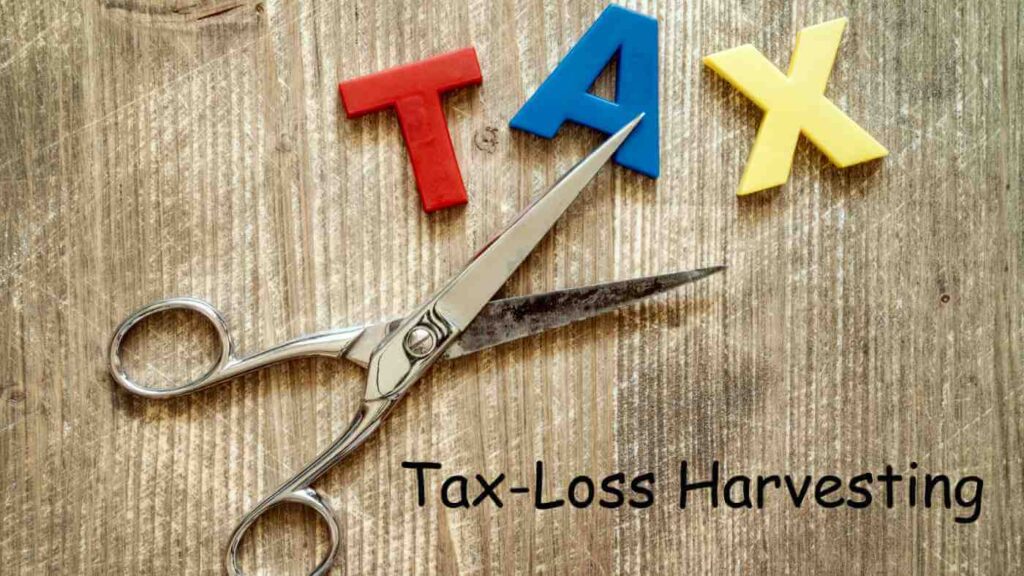Tax-loss harvesting is a strategic approach investors use to minimise their tax liabilities by selling securities that have experienced a loss. This practice is precious in offsetting capital gains taxes and enhancing overall investment returns. Let’s delve deeper into what tax-loss harvesting entails and how it can be effectively utilised.

What is Tax-Loss Harvesting?
Tax-loss harvesting involves selling investments that have incurred losses to offset or reduce taxes on capital gains. When an investor sells a share/security at a loss, they can utilise that loss to counterbalance any capital gains earned from other investments, thereby decreasing their taxable income. This proactive approach can help investors optimise their tax liabilities and increase their after-tax returns.
Example of Tax-Loss Harvesting:
Consider an individual who has earned ₹1 lakh in Short-Term Capital Gains (STCG) during the tax year. According to the prevailing tax rate of 15%, they would owe ₹15,000 in taxes on these gains. However, if the individual also holds stocks with an unrealized loss of ₹60,000, they can strategically sell these stocks to offset their capital gains.
By selling the stocks with a loss, the individual reduces their net STCG to ₹40,000. Applying the 15% tax rate, they would now owe only ₹6,000 in taxes, resulting in a tax savings of ₹9,000. This process demonstrates how tax-loss harvesting can effectively minimise tax obligations and enhance overall returns.
Arbitrage Opportunities:
Historically, tax loss harvesting provided significant arbitrage opportunities when short-term capital gains tax rates were higher than long-term capital gains tax rates. However, with the current tax landscape, where short-term and long-term capital gains tax rates difference is only 5%, the appeal of this arbitrage has remained strong.
Considerations Before Implementing Tax-Loss Harvesting:
Before engaging in tax loss harvesting, consider the following factors:
1. Arbitrage Gains: Assess whether the potential tax savings justify the transaction costs, price variation risks, and administrative complexities associated with tax loss harvesting.
2. Booked Loss Reversal: Understand that tax loss harvesting alters the ‘cost basis’ of the shares. If the share’s value rebounds after harvesting, selling it later may trigger capital gains taxes based on the revised cost basis.
Execution Strategies:
When implementing tax loss harvesting, it’s crucial to execute the strategy thoughtfully:
1. Transaction Timing: To avoid speculative transaction classification, buy the shares the next day after selling. This ensures the transaction is viewed as a legitimate investment move.
2. Portfolio Reconsideration: Consider selling shares with losses and purchasing them in your spouse’s, children’s, or HUF’s portfolio simultaneously. While not conventional tax loss harvesting, this strategy allows for a reassessment of your portfolio.
Additional Considerations:
Although tax loss harvesting can offer significant benefits to investors, it’s essential to be aware of specific considerations:
1. Wash Sale Rules: In the United States, if an investor sells a security at a loss and buys back the same or substantially identical/similar security within 30 days before or after the sale, it is classified as a “wash sale.” The IRS disallows tax benefits for such transactions. Investors need to be mindful of these rules to avoid unintended consequences.
2. Consultation with Tax Professionals: Investors are advised to seek guidance from tax professionals, such as Chartered Accountants (CAs), to ensure adherence to tax regulations and optimise their tax strategies. In jurisdictions like India, where explicit regulations on tax loss harvesting may be lacking, professional advice can help navigate potential tax implications effectively.
3. Documentation and Record-Keeping: Maintaining accurate records of investment transactions is crucial for demonstrating the legitimacy of tax loss harvesting activities. Proper documentation supports tax filings and protects investors during tax audits or scrutiny.
Final Words:
Tax-loss harvesting is a proactive strategy that empowers investors to mitigate tax liabilities and enhance investment returns. By strategically selling underperforming investments to offset capital gains, investors can optimise their after-tax returns and improve overall portfolio performance. However, it’s essential to understand the rules and considerations associated with tax loss harvesting and seek professional guidance to ensure compliance and maximise benefits.
Incorporating tax-loss harvesting into investment strategies can be valuable for investors seeking to optimise their tax efficiency and achieve long-term financial goals. With meticulous planning and execution, tax loss harvesting has the potential to accumulate wealth and safeguard financial futures.
